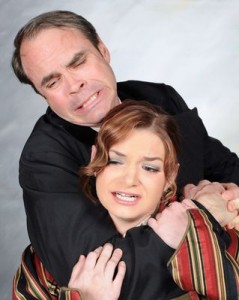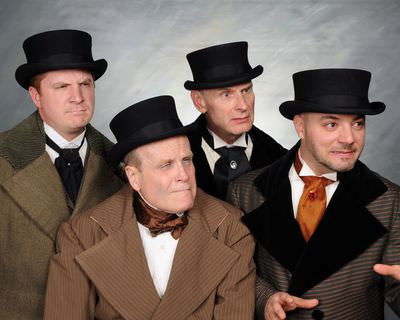I’ll tell you what I know. What I saw, what I heard; the events as I would recall them as I witnessed the Vagabond Players’ production of Dr. Jekyll and Mr. Hyde, a new adaptation by Jeffrey Hatcher. Not at all your grandfather’s interpretation of the twisted novella The Strange Case of Dr. Jekyll and Mr. Hyde by Robert Louis Stevenson, this new rendition of the classic dark story explores the notion of the Hyde within us all; a warped yet ingenious approach to reviving life into a lost classic. Directed by John W. Ford, the story is haunting, mesmerizing and intriguing in ways unimaginable.

Victorian London is represented with a sharp flare compliments of Costumer Mary Bova. While Elizabeth’s dress may look like a number created out of garish curtains, they are of an appropriate color scheme and pattern suited for the era. Bova’s design work errs on the side of simplicity which in this production is a smart move; keeping the notion of the period well represented in the flared waist coats and fitted trousers and little else. Not falling for the trite trap of using costumes to shift characters in and out of existence as six actors play nearly two dozen characters, Bova’s designs allow the actors’ performance to speak outside the boundaries of such a device.
Creating atmospheric tension in this thriller is a crucial element of the design team. Sound Designer Devin McKay does implement several segments of truly haunting music that fits the scene transitions beautifully. McKay creates a particularly striking moment when Hyde’s final narration at the close of the production is underscored with a moment of eerie string composition. The production could use more of these moments as there are several long narrations from many different characters that sit otherwise in silence. There are also scene changes that could benefit from more of McKay’s design work.
Director John W. Ford has chosen a fascinating adaptation to work with; a reinvention of the notion of Dr. Jekyll’s monster with many characters. The adaptation, written by Jeffrey Hatcher, brings together two dozen characters with only six actors, five of which rotate through the course of the show playing Mr. Hyde in some form or another with a six man solely playing Jekyll. It brings a new approach to the classic work and is a bold choice of Ford’s to work with this adaptation.
That said, Ford handles the production exceptionally well. Serving as the show’s Set Designer the infamous ‘red door’ is a tremendously important set piece that astonishes in its simplicity. Ford makes the door mobile on wheels rather than just a fixed point upon the stage, allowing for it to take on a sort of omnipotence and almost become a secondary character. The brilliance in this duality is that both sides of the door are red so that regardless if it is Jekyll at the door or Hyde, the identical coloring shows that there is no difference between the men.
The overall effect of having five different actors playing Hyde at first is troublesome, but Ford’s general direction seems to unite them. While there needed to be more of a push for them to share similar mannerisms and gestures, they did all adapt a rather edgy gravel to their voice, giving them the unbridled sound of unrestrained anger when they spoke. That said there were definitely moments when the nightmarish characterization of Hyde could have been pushed into a darker place, evoking a more sinister notion of the character across the board.
Tiffany Spaulding, as the only female in the production, makes her presence known and the startling vigor with which she portrays Elizabeth is refreshing compared to most melancholic and frightened young women that would encounter such creatures as Dr. Jekyll and Mr. Hyde. Her ability to shift quickly between outbursts of true terror and those of a staunch and unyielding love are impressive, as is her ability to maintain consistency with her British accent.
Thom Peters carries off a series of roles with clean concise demarcation lines between them; the main two being Carew, a rival doctor of Jekyll’s, and Poole, Jekyll’s house servant. Peters creates such a sharp distinguished difference between these two characters that despite the simple addition of a mortuary smock and monocle to change from Poole to Carew, it often feels as if they are being played by two different actors. It is his portrayal of the worried to death Poole that really catches the eye; the nervous cadence with which he speaks and the fidgety gestures that radiate throughout his body to showcase his tremulous worry for his master that grip the audience quite soundly.
While everyman save Jekyll takes a stab at Hyde, the main antagonist’s portrayal comes from Tom Moore. Doubling a fair bit as Lanyon, the Scottish consort of Jekyll, he finds an equally stunning way to split the characters into two separate compartments. Moore’s approach to Hyde is disturbing; a haunting and distorted portrayal that leaves all watching feeling violated in their soul simply by hearing his voice or gazing up into his demented eyes. Finding a thin and fragile layer of tenderness beneath that monster, Moore manages to let Elizabeth’s love effect his tormented existence, creating a deeply dynamic portrayal of this sinister creature.

But it is Dr. Jekyll (Gregory Guyton) who truly mesmerizes us. The precarious madness that sits ever-presently balanced just at the edge of Guyton’s consciousness is harrowing and adds a thrilling fright to the performance. Guyton handles the division of Hyde from Jekyll superbly; still manifesting many of those tendencies which should solely belong to Hyde in his performance. There are several moments in the production where Moore’s Hyde is present but only audible to Guyton’s Jekyll and these are the most profound scenes as you can see the transformation splaying out across Guyton’s face; the shift in his voice, even his posture as he struggles to keep the monster within him despite the highly symbolic representation of having Hyde hovering alongside him. Guyton’s performance is genuine; a masterful rendition of this classic literary icon and all his struggles.
Running Time: One hour and 45 minutes, with one intermission.
Dr. Jekyll and Mr. Hyde plays through March 30, 2014 at Vagabond Players — 806 South Broadway, in Baltimore, Maryland. For tickets, call the box office at (410) 563-9135, or purchase them online.




